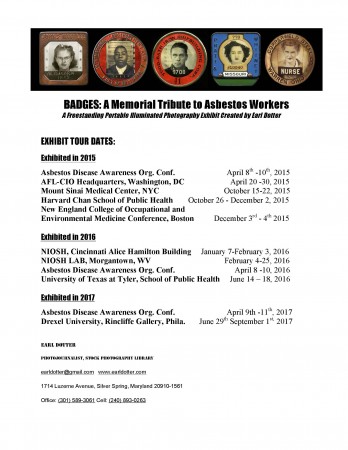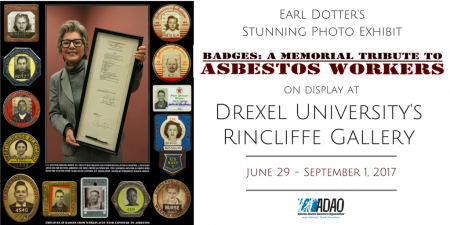Posted on May 25, 2017 | Updated on June 20, 2017
The third iteration of Earl Dotter’s groundbreaking photojournalism series “Badges: A Memorial Tribute to Asbestos Workers,” which celebrates the 2016 passage of TSCA reform, will be on display at Drexel University from June 29 – September 1.
The Asbestos Disease Awareness Organization (ADAO) has been a proud sponsor of “BADGES” since its inception, and we are thrilled to see it shown at such a prestigious university — a perfect backdrop to inspire conversations about the art, advocacy, public health, and social justice. I am thrilled I’ll have the opportunity to represent ADAO at the opening night reception on June 29, along with ADAO Science Advisory Board Co-Chair Dr. Arthur Frank.
“Universities should be sites of diverse views of the world, and linking different disciplines is what universities should be doing,” said Dr. Frank, who is also Chair of the Department of Environmental and Occupational Health Drexel’s School of Public Health. “As a professional working in occupational health to show the role of Earl Dotter’s work and how it educates does such linkage.”
The exhibit, which honors the legacy of asbestos research and workers health advocate Dr. Irving J. Selikoff, features ID badges worn by asbestos workers who spent their lives unknowingly mining and manufacturing products containing a lethal amount of asbestos, connecting the human faces to the industry. The companies were aware of the deadliness of their products, just as they are aware today, yet in many cases these dangers were ignored.
“By personalizing those workers, shown in my exhibits, who have devoted at least a third of their lives making a living, it is for me important to present in photograph the cost to them and their families of lost health and shortened life spans due to unsafe and unhealthy work practices and exposures,” Mr. Dotter explained. “And I think it will come as a surprise to many that today 15,000 new cases of asbestos related diseases are identified annually in the U.S. alone, and that annual toll is STILL not decreasing.”
 This newest expression of the exhibit focuses on last year’s passage of important reforms to the Toxic Substances Control Act (TSCA), which paves the way for the federal government to finally ban asbestos. The exhibit features a portrait of U.S. Senator Barbara Boxer, who was instrumental in ensuring meaningful TSCA reform and has been a stalwart champion for public health and the environment for years. Tragically, asbestos is still legal and lethal in the United States, but with common sense policy reform and the tireless dedication of advocates like Sen. Boxer, physicians like Dr. Selikoff, and many others, working to end this manmade disaster, hopefully we will see this change soon.
This newest expression of the exhibit focuses on last year’s passage of important reforms to the Toxic Substances Control Act (TSCA), which paves the way for the federal government to finally ban asbestos. The exhibit features a portrait of U.S. Senator Barbara Boxer, who was instrumental in ensuring meaningful TSCA reform and has been a stalwart champion for public health and the environment for years. Tragically, asbestos is still legal and lethal in the United States, but with common sense policy reform and the tireless dedication of advocates like Sen. Boxer, physicians like Dr. Selikoff, and many others, working to end this manmade disaster, hopefully we will see this change soon.
“With each of our particular skill sets there is a role to play,” Mr. Dotter said. “In medicine we need new research to identify better treatments for mesothelioma and other asbestos related illnesses. If you are an architect concerned about healthy building design, in the U.S. and worldwide, there is a role advocating for a total ban in this mineral’s use, especially in connection with new housing construction. As a student identifying with public health concerns, it is important to understand that most new cases of asbestos disease are contracted from unexplained or idiopathic sources, now embedded into our built environment.”
“As visual artists,” Mr. Dotter continued, “I am reminded of the Bertolt Brecht quote, ‘Art is not a mirror held up to reality, but a hammer with which to shape it.'”
Mr. Dotter will be giving a gallery talk at the exhibit’s grand opening on June 29, and Dr. Frank will be giving a gallery talk about the show on July 11 at noon. There will also be a satellite exhibit in the lobby of the School of Public Health.
Dr. Frank hopes the exhibit at Drexel will “over the months, educate folks from far and wide about the hazards of work.”
“The old cliché of a picture being worth a thousand words certainly applies,” Dr. Frank said. “Earl’s work is at the pinnacle of those who try to document the world of work.”
***

***
In unity,
Linda

